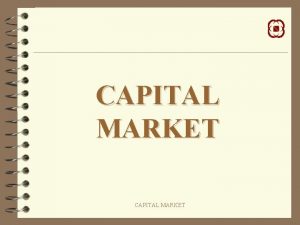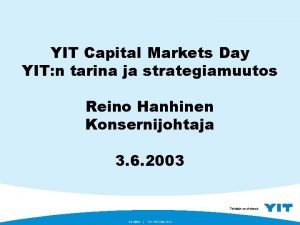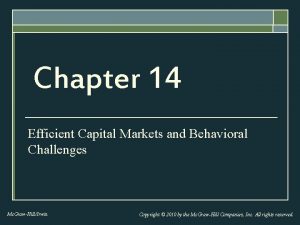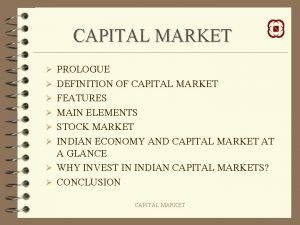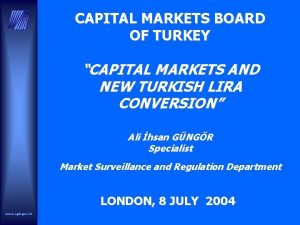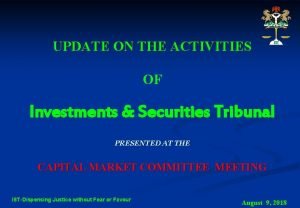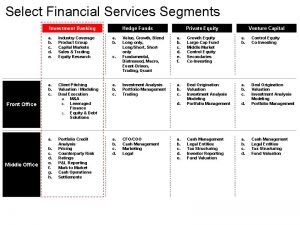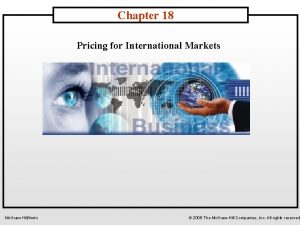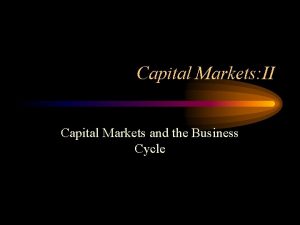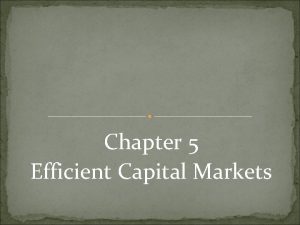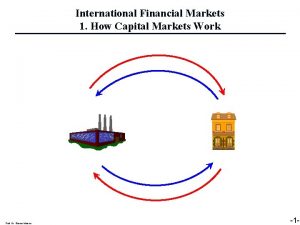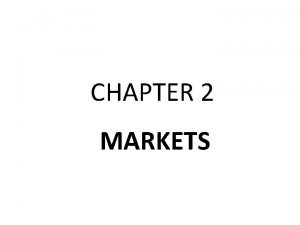International Capital Markets International capital markets are a












- Slides: 12

International Capital Markets • International capital markets are a group of markets (in London, Tokyo, New York, Singapore, and other financial cities) that trade different types of financial and physical capital (assets), including ¨ stocks ¨ bonds (government and corporate) ¨ bank deposits denominated in different currencies ¨ commodities (like petroleum, wheat, bauxite, gold) ¨ forward contracts, futures contracts, swaps, options contracts ¨ real estate and land ¨ factories and equipment

Gains from Trade • How have international capital markets increased the gains from trade? • When a buyer and a seller engage in a voluntary transaction, both receive something that they want and both can be made better off. • A buyer and seller can trade ¨ goods or services for other goods or services ¨ goods or services for assets ¨ assets for assets Copyright © 2006 Pearson Addison-Wesley. All rights reserved. 21 -2

Gains from Trade (cont. ) Copyright © 2006 Pearson Addison-Wesley. All rights reserved. 21 -3

Gains from Trade (cont. ) • The theory of comparative advantage describes the gains from trade of goods and services for other goods and services Copyright © 2006 Pearson Addison-Wesley. All rights reserved. 21 -4

Gains from Trade (cont. ) • The theory of intertemporal trade describes the gains from trade of goods and services for assets, of goods and services today for claims to goods and services in the future (today’s assets). ¨ Savers want to buy assets (future goods and services) and borrowers want to use assets (wealth) to consume or invest in more goods and services than they can buy with current income. ¨ Savers earn a rate of return on their assets, while borrowers are able to use goods and services when they want to use them: they both can be made better off. Copyright © 2006 Pearson Addison-Wesley. All rights reserved. 21 -5

Gains from Trade (cont. ) • The theory of portfolio diversification describes the gains from trade of assets for assets, of assets with one type of risk with assets of another type of risk. Many times in economics people want to avoid risk: they would rather have a sure gain of wealth than invest in risky assets. ¨ Economists say that investors often display risk aversion: they are averse to risk. ¨ Diversifying or “mixing up” a portfolio of assets is a way for investors to avoid or reduce risk. ¨ Copyright © 2006 Pearson Addison-Wesley. All rights reserved. 21 -6

Classification of Assets Claims on assets (“instruments”) are classified as either 1. Debt instruments ¨ Examples include bonds and bank deposits ¨ They specify that the issuer of the instrument must repay a fixed value regardless of economic circumstances. 2. Equity instruments ¨ Examples include stocks or a title to real estate ¨ They specify ownership (equity = ownership) of variable profits or returns, which vary according to economic conditions. Copyright © 2006 Pearson Addison-Wesley. All rights reserved. 21 -7

The Structure of International Capital Markets and Offshore Banking • James Grant Copyright © 2006 Pearson Addison-Wesley. All rights reserved. 21 -8

Regulation of International Banking • Kyle Briggs and Shwetambari Heblikar Copyright © 2006 Pearson Addison-Wesley. All rights reserved. 21 -9

How Well Has the International Capital Market Performed? • The international capital market allows residents of different countries to diversify their portfolios by trading risky assets. • By ensuring a rapid international flow of information about investment opportunities around the world, the market can help allocate the world’s saving to their most productive uses. Copyright © 2006 Pearson Addison-Wesley. All rights reserved. 21 -10

Extent of International Portfolio Diversification • In 1999, US owned assets in foreign countries represented about 30% of US capital, while foreign assets in the US was about 36% of US capital. ¨ These percentages are about 5 times as large as percentages from 1970, indicating that international capital markets have allowed investors to increase diversification. • Likewise, foreign assets and liabilities as a percent of GDP has grown for the US and other countries. Copyright © 2006 Pearson Addison-Wesley. All rights reserved. 21 -11

Extent of International Portfolio Diversification (cont. )
 Antigentest åre
Antigentest åre Structure of capital markets
Structure of capital markets Metsä board osinko
Metsä board osinko Efficient capital markets and behavioral challenges
Efficient capital markets and behavioral challenges Features of capital market
Features of capital market Capital markets and financial intermediation
Capital markets and financial intermediation Efficient capital allocation
Efficient capital allocation Capital markets board of turkey
Capital markets board of turkey Investment and securities tribunal
Investment and securities tribunal Investment banking vs capital markets
Investment banking vs capital markets Efficient capital markets ii
Efficient capital markets ii Contrasting international markets
Contrasting international markets Pricing for international markets
Pricing for international markets

